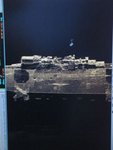SimHQ Forums: OT: wreck of Graf Zeppelin located?
Two weeks ago, on the 12th of July 2006, a ship belonging to Petrobaltic (a Polish oil company) found a 265 m. long wreck close to the port of Łeba which may be the Graf Zeppelin
From
German aircraft carrier Graf Zeppelin - Wikipedia, the free encyclopedia
MaritimeQuest - Graf Zeppelin
Two weeks ago, on the 12th of July 2006, a ship belonging to Petrobaltic (a Polish oil company) found a 265 m. long wreck close to the port of Łeba which may be the Graf Zeppelin
As the end of World War II neared, the roughly completed carrier was scuttled in shallow water at Stettin (now Szczecin) on 25 April 1945, just before the Red Army captured the city. After Germany's surrender, though, its history and fate is unclear. According to the terms of the Allied Tripartite Commission, a "Category C" ship (damaged or scuttled) should have been destroyed or sunk in deep water by 15 August 1946. Instead, the Russians decided to repair the damaged ship. It was refloated in March, 1946. The last known photo of the carrier shows it leaving Swinemuende (now Swinoujscie on 7 April 1947 (see picture). The photo appears to show the carrier deck loaded with various containers, boxes and construction elements, hence the supposition that it was probably used to carry looted factory equipment from Poland and Germany to the Soviet Union.
For many years no other information about the ship's fate was available. There was some speculation that it was very unlikely that the hull made it to Leningrad, as it was argued that the arrival of such a large and unusual vessel would have been noticed by Western intelligence services. This assumption seemed to imply that the hull was lost at sea during transfer between Swinemuende and Leningrad. One account concluded that it struck a mine north of Rügen on 15 August 1947, but Rügen, west of Swinemuende, is not on the sailing route to Leningrad. Further north, in the Gulf of Finland, a heavily-mined area difficult for Western observers to monitor, seemed more likely.
After the opening of the Soviet archives, new light was shed on the mystery. It appears that the carrier was towed to Leningrad. There, after unloading, it was designated as "PO-101" (Floating Base Number 101). The Russians hoped that the carrier could be repaired in Leningrad's shipyards (those in Szczecin were destroyed). When this proved impractical, the ship was towed out to sea, back to the Swinemuende area. There, on 16 August 1947, it was used as a practice target for Soviet ships and aircraft. Allegedly, the Soviets installed aerial bombs on the flight deck, in hangars and even inside the funnels (to simulate a load of combat munitions), and then dropped bombs from aircraft, fired shells, and shot torpedoes into it. This assault would both comply with the Tripartite mandate (albeit late) and provide the Soviets with experience in sinking an aircraft carrier. By this point, the Cold War had well begun, and the Soviets were well aware of the large numbers and central importance of aircraft carriers in the US Navy, which in the event of an actual war between the Soviet Union and America would be targets of high strategic importance. Hence, experience in sinking carriers by aircraft was much more valuable in 1947 than before 1945. After being hit by 24 bombs and projectiles, the ship did not sink and had to be finished off by torpedoes. The exact position of the wreck was unknown for decades. On 12 July 2006 a ship belonging to Petrobaltic (a Polish oil company) found a 265 m. long wreck close to the port of Łeba which probably is the Graf Zeppelin. [1]
From
German aircraft carrier Graf Zeppelin - Wikipedia, the free encyclopedia
MaritimeQuest - Graf Zeppelin











